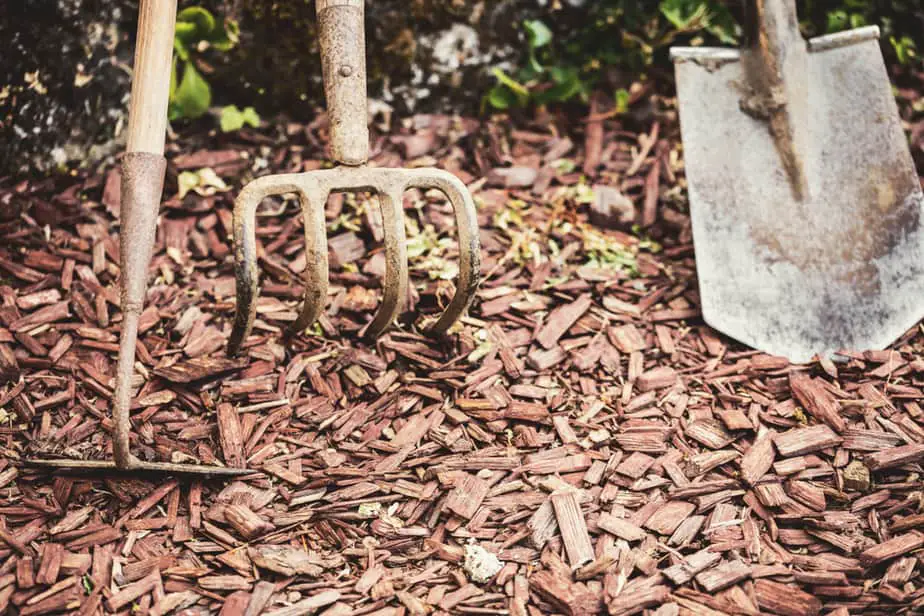Table of Contents
What Is Mulch and What Is It For?
Mulch is material covering the ground to keep the soil moist and protect plant roots from heat or cold. Mulching helps to reduce weeds and can improve a garden’s appearance.

Also, while your vegetable or flower beds will not be used in the winter months, wind or rain can remove the soil from these beds unless they are protected. This is where mulch comes in.
Organic mulch helps improve the soil’s fertility as it decomposes.
Organic mulch includes:
- Bark
- Compost
- Composted Manure
- Grass Clippings
- Newspaper
- Shredded Leaves
- Straw
- Hay
Inorganic mulch includes stone or gravel and black plastic.
Whatever mulch you decide on, take the time to cultivate and water it before laying mulch.
What Is Old Mulch?
Old mulch refers to mulch that remains intact one year after it was laid.
Should I Remove Old Mulch?
It is not necessary to remove old mulch – as long as it has not decomposed significantly.
You can tell whether it is still usable by picking some of it up. If it has turned into fine particles, like dirt, it could be replaced. Alternatively, you can work it into the soil, and it will serve a similar function as compost as it is organic matter.
Usable old much will keep breaking down, adding more nutrients and organic matter to your soil. It acts as a slow-release fertilizer.
Removing old mulch is time consuming and hard work. Leaving it on the ground also means you will not have to get as much new mulch, which will save you money.
Removing old mulch might also cause significant root damage to your plants.
If your plants in a particular garden bed experienced disease last year and you think this may be related to the mulch, you could consider removing it.
If your mulch has knitted together, you do not need to remove it. Fluff the mulch with a rake, and add more on top. However, if you notice a fungus or mold, use a fungicide, or remove the mulch if it is severely damaged.
You only need to remove old mulch completely if you are using a material such as engineered wood fiber or other engineered material.
How Do I Reuse Old Mulch?
Before planting time, rake the old much to one side, to prepare the garden bed. Put compost on the bed and work it into the soil. Then put the old mulch back and add any new mulch you need.
When you plant, gently move aside the mulch to put your plants or seeds in, and then replace it.
How Much New Mulch Will I Need?
How much mulch you will need depends on the height of your old mulch. Mulch should ideally be about two inches high on flower beds and three inches deep over shrub beds and around tree stumps. You only need to add new mulch if the old mulch does not provide enough cover.
Take care not to add too much new mulch. If it is too deep, your plant roots might suffocate, your soil can overheat if it is sunny, or your soil might not get enough water. If your thick mulch gets too wet, it can encourage the spread of disease.
If you decide to put mulch around a tree, it is important the mulch not be too thick, especially around the tree trunk. A “mulch volcano” can cause disease from any excess moisture in the mulch adjacent to the bark.
If you cannot find new mulch in the same color as the old mulch, it will weather it to the old color.
When Should I Mulch?
Spring is usually the time to lay down mulch when the soil is warm and watered. Spread the mulch loosely to allow the air to get into the soil. The mulch can protect your beds from intense heat during the summer months.
The exact time in spring to lay mulch will depend on where you live and when your perennials usually start pushing up new growth. The ground should be beginning to thaw, and any chance of a hard frost should have passed.
Before laying new mulch, you may want to remove some of the old mulch on top of your perennial garden beds to let the air circulate.
If you lay mulch too early, your new plants might become damaged or their leaves might become disfigured.
It is sensible to wait to mulch until your perennials have come up and have got some height. Apply some mulch around them, which will keep weeds at bay.
Mulch can also be laid in the fall and will act as an insulator to keep any harsh winter weather from eroding your soil.
What About Cover Crops?
Cover crops, also known as a living mulch, are made of annual flower beds, and vegetable gardens sowed over in the fall to protect them in winter. This is useful when you have a large garden.
Remove the cover crops in the spring when you are ready to plant.
Mow first, then use a garden tiller over the garden — this is called “tilling under” the cover crops. This will free up your garden for your plants and gives your soil lots of nutrients. Then spread compost and till that under too.
Final Thoughts
Old mulch can either be removed completely or used with the new mulch for your garden. Natural mulch will slowly degrade and provide nutrients in the soil, while synthetic mulch won’t degrade or will not provide any nutrients.